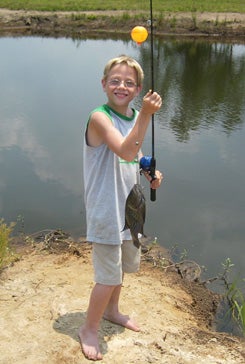SCIENTIFIC NAME: Lepomis gulosus
CHARACTERISTICS: The warmouth, like the shadow bass and rock bass, is known locally as goggle-eye. This species has 36 to 44 lateral line scales. The dorsal fin contains nine to 11 spines and usually 10 rays. The anal fin has three spines (rock and shadow bass have six) and nine or 10 rays. The mouth is large; the upper jaw reaches the middle of the eye or slightly beyond. A small patch of teeth on the tongue can be detected by rubbing its upper surface. One or two anterior and three or four posterior dark streaks radiate out from the eye. The back and sides are yellowish brown with dark blotches and mottling. The venter is light yellow to brown. Young individuals have a light horizontal stripe near the lateral line. Fins are light brown with mottling and banding, particularly near the rear of the soft dorsal and anal fins. See Cuvier and Valenciennes (1829) for original description.
ADULT SIZE: 6 to 8 in (152 to 203 mm).
STATE RECORD:
a list of the State Record Freshwater Fish.
DISTRIBUTION: Warmouth are found in every river system in Alabama but are abundant only in the Mobile Delta and lower sections of the Alabama and lower Tombigbee rivers.
HABITAT AND BIOLOGY: Warmouth usually occur around concentrations of aquatic vegetation and submerged roots and brush piles in medium to large streams, rivers, and reservoirs. We found them in greatest abundance in the Mobile Delta during late summer when lower river discharge and greater tidal intrusion elevated salinity values to one to 15 parts per thousand. Small freshwater shrimp of the genus Palaemonetes are an important food item for warmouth (Forbes, 1903) and were extremely abundant in our collections. Other prey include small crayfishes, aquatic insect larvae, and minnows. Malvestuto et al. (1983) report that anglers landed 16,666 pounds of warmouth in the Mobile Delta and the Alabama and lower Tombigbee river drainages in 1980 and 1981. A detailed study of warmouth life history in Illinois was completed by Larimore (1957). Spawning occurs in May and June near stumps or aquatic vegetation, but not over a clean, sandy bottom. Nests are guarded by males for several days until the fry hatch. Carlander (1977) finds that males of this species grow faster than females. Most individuals live six to seven years. Although they put forth a respectable fight on light tackle, warmouth are not a popular panfish because of their small size.
ORIGINAL DESCRIPTION: Cuvier described the warmouth in 1829.
ETYMOLOGY:
Lepomis means scaled operculum.
Gulosus means large-mouthed.
This copyrighted information is from the Fishes of Alabama and the Mobile Delta.







